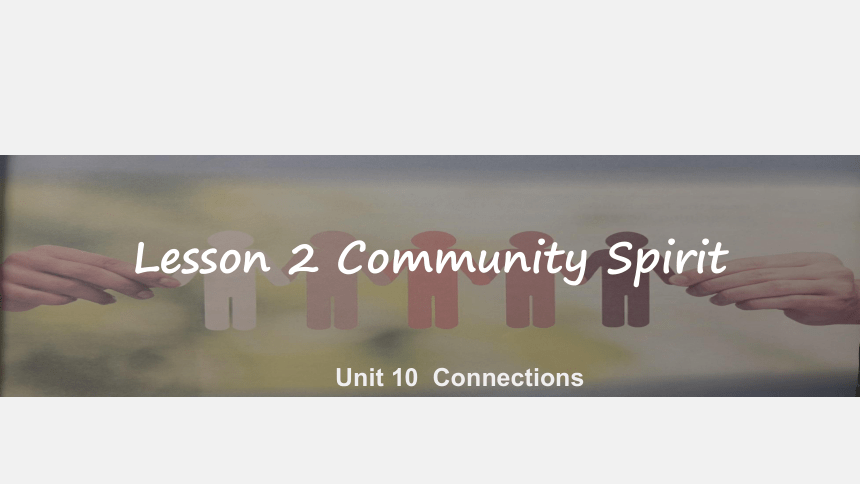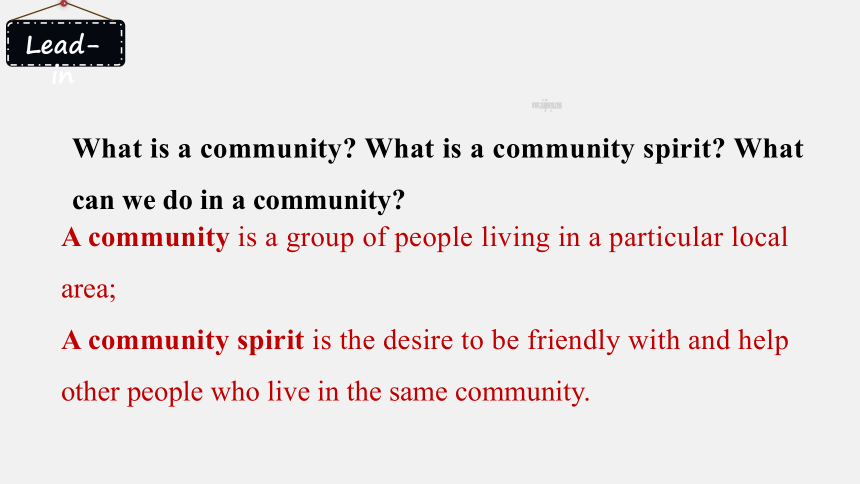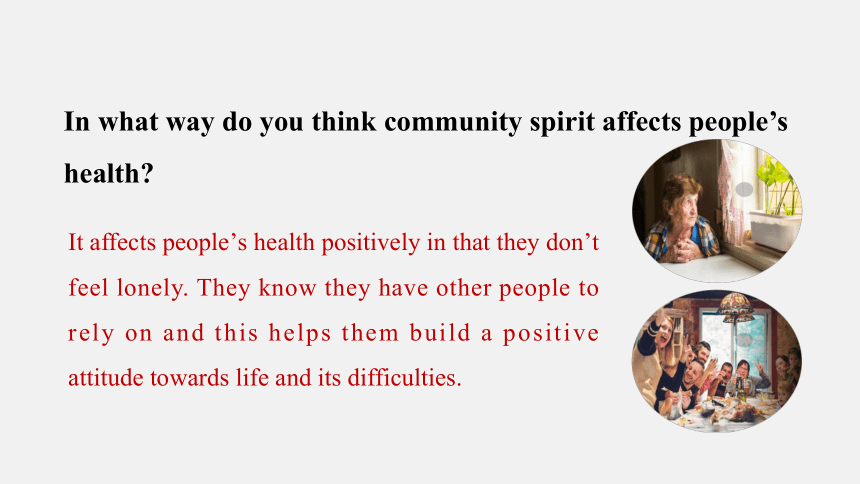北师版(2019)选择性必修4 Unit10 Connections Lesson 2 Community Spirit课件(共19张PPT,内镶嵌音频)
文档属性
| 名称 | 北师版(2019)选择性必修4 Unit10 Connections Lesson 2 Community Spirit课件(共19张PPT,内镶嵌音频) |

|
|
| 格式 | pptx | ||
| 文件大小 | 13.2MB | ||
| 资源类型 | 教案 | ||
| 版本资源 | 北师大版(2019) | ||
| 科目 | 英语 | ||
| 更新时间 | 2024-04-27 17:52:37 | ||
图片预览







文档简介
(共19张PPT)
Unit 10 Connections
Lesson 2 Community Spirit
By the end of this period, you will be able to:
1.listen and talk about community spirit;
2.listen for understanding and detail;
3. listen for specific information and understand words in the context;
4.practice using vague language;
5.talk about your own community.
What is a community What is a community spirit What can we do in a community
Lead-in
A community is a group of people living in a particular local area;
A community spirit is the desire to be friendly with and help other people who live in the same community.
What can we do in a community
respect elderly people
look after each other
beautify the community environment
help the people in need
organize community celebrations
visit each other
community spirit
do some voluntary work
In what way do you think community spirit affects people’s health
It affects people’s health positively in that they don’t feel lonely. They know they have other people to rely on and this helps them build a positive attitude towards life and its difficulties.
Listen for understanding.
1.Where is the interview taking place
_________________________________________________________
2.What’s the interview about
_________________________________________________________
_________________________________________________________
Predict the content of the interview according to the instructions and the exercises or notes.
The interview is talking about how the community spirit of a small town called Roseto impacted on the residents’ health.
In a radio programme.
Pre-listening
1.What surprising facts did doctors discover about Rosetans in the 1950s
2. What was the reason for the facts
There was almost no death from heart attack even though it was an epidemic then in the USA. Besides, there was very little crime.
The reason for its low rate of heart attacks was the community itself.
While-listening
Activity 1: Listen to the dialogue and answer the following questions.
Activity 2: Listen to the interview again and complete the table about the Roseto community in the 1950s and 1960s.
In the 1950s In the 1960s
Community life was a very ______ community looked after each other _____each other frequently organized ________ households consisted of _____ old people ____________ younger Rosetans would not __________
moved to typical ______
rejected ___________
Consequences hardly a Rosetan below 65 ___ people were dying _____rather than _______ very little _________ the first heart attack of a Rosetan under 45
happened in___
the rate of heart attacks is_________
In the 1950s
Community life was a very ___________ community
looked after each other
______each other
frequently organized ____________________
households consisted of ______________
old people _____________
Consequences hardly did a Rosetan below 65
_______________________
people were dying _________rather than __________
very little _____
community celebrations
closely-knit
visited
three generations
were respected
of old age
from illness
crime
experience a heart attack
In the 1960s
Community life younger Rosetans would not keep up ___________________
moved to typical __________________
rejected _____________________
Consequences the first heart attack of a Rosetan under 45 happened in_____
the rate of heart attacks is____________________
the traditional lifestyles
single-family houses
traditional social bonds
the same as the average
1971
Focus on function: Vague Language
What is the dialogue about
————————————————————————————————————————————————————
The dialogue is a conversation between Linda and her grandfather about how life was like in her mother’s hometown.
Predict the content of the dialogue according to the information given.
Pre-listening
1. What information did Linda get from her mother about the hometown
A. It is small. B. It is big like a city. C. It is inconvenient.
2. What was the relationship between neighbors at that time
A. They brought inconvenience to each other.
B. They were friendly to each other.
C. They seldom visited each other.
3.What will grandpa probably do this afternoon
A.He will visit some neighbors.
B.He will stay at home and welcome some old friends.
C.He will show Linda around his hometown.
√
√
√
While-listening
Activity 1: Listen to the dialogue and choose the best answers.
Mum’s hometown ______________.
There weren’t __________________.
They didn’t live in flats but in ______________________________.
The kitchen and toilet were_________________.
were small
with two small rooms
many tall buildings
outside the house
1.What was her mother’s hometown and living conditions like in the past
Hometown
and living conditions in the past
Activity 2: Listen to the dialogue again and fill in the blanks.
They were close to ____________.
They were ____________.
They were just like ______________.
Children ________________________.
Neighbours ______________________.
neighbors
a big family
friendly
played together after school
2.What were the relationships with neighbors in the past
often visited each other
Relationships with neighbours
Activity 3: Listen again and fill in the blanks with expressions that the speakers used.
Vague Language
Similar to something
Mum always tells me her hometown is small, but this is ________ a big city.
Part of a category
We lived in _________ house …
We were friendly to each other, just like _________ big family.
Less in quality
It was _____ inconvenient.
like
a bit
a kind of
a sort of
like
a sort of
a kind of
a bit
Talk Builder
For what purpose would you use vague language
Purposes
To make a statement less strong.
When we don’t know the name of something.
To make things sound less factual.
To talk about groups and categories.
Activity 4: Answer the question below.
Introduce the community where you live with as much factual information as possible, using vague language where appropriate.
Pair work
Introduction to your community
Living conditions
Relationships with neighbours
Post-listening
Unit 10 Connections
Lesson 2 Community Spirit
By the end of this period, you will be able to:
1.listen and talk about community spirit;
2.listen for understanding and detail;
3. listen for specific information and understand words in the context;
4.practice using vague language;
5.talk about your own community.
What is a community What is a community spirit What can we do in a community
Lead-in
A community is a group of people living in a particular local area;
A community spirit is the desire to be friendly with and help other people who live in the same community.
What can we do in a community
respect elderly people
look after each other
beautify the community environment
help the people in need
organize community celebrations
visit each other
community spirit
do some voluntary work
In what way do you think community spirit affects people’s health
It affects people’s health positively in that they don’t feel lonely. They know they have other people to rely on and this helps them build a positive attitude towards life and its difficulties.
Listen for understanding.
1.Where is the interview taking place
_________________________________________________________
2.What’s the interview about
_________________________________________________________
_________________________________________________________
Predict the content of the interview according to the instructions and the exercises or notes.
The interview is talking about how the community spirit of a small town called Roseto impacted on the residents’ health.
In a radio programme.
Pre-listening
1.What surprising facts did doctors discover about Rosetans in the 1950s
2. What was the reason for the facts
There was almost no death from heart attack even though it was an epidemic then in the USA. Besides, there was very little crime.
The reason for its low rate of heart attacks was the community itself.
While-listening
Activity 1: Listen to the dialogue and answer the following questions.
Activity 2: Listen to the interview again and complete the table about the Roseto community in the 1950s and 1960s.
In the 1950s In the 1960s
Community life was a very ______ community looked after each other _____each other frequently organized ________ households consisted of _____ old people ____________ younger Rosetans would not __________
moved to typical ______
rejected ___________
Consequences hardly a Rosetan below 65 ___ people were dying _____rather than _______ very little _________ the first heart attack of a Rosetan under 45
happened in___
the rate of heart attacks is_________
In the 1950s
Community life was a very ___________ community
looked after each other
______each other
frequently organized ____________________
households consisted of ______________
old people _____________
Consequences hardly did a Rosetan below 65
_______________________
people were dying _________rather than __________
very little _____
community celebrations
closely-knit
visited
three generations
were respected
of old age
from illness
crime
experience a heart attack
In the 1960s
Community life younger Rosetans would not keep up ___________________
moved to typical __________________
rejected _____________________
Consequences the first heart attack of a Rosetan under 45 happened in_____
the rate of heart attacks is____________________
the traditional lifestyles
single-family houses
traditional social bonds
the same as the average
1971
Focus on function: Vague Language
What is the dialogue about
————————————————————————————————————————————————————
The dialogue is a conversation between Linda and her grandfather about how life was like in her mother’s hometown.
Predict the content of the dialogue according to the information given.
Pre-listening
1. What information did Linda get from her mother about the hometown
A. It is small. B. It is big like a city. C. It is inconvenient.
2. What was the relationship between neighbors at that time
A. They brought inconvenience to each other.
B. They were friendly to each other.
C. They seldom visited each other.
3.What will grandpa probably do this afternoon
A.He will visit some neighbors.
B.He will stay at home and welcome some old friends.
C.He will show Linda around his hometown.
√
√
√
While-listening
Activity 1: Listen to the dialogue and choose the best answers.
Mum’s hometown ______________.
There weren’t __________________.
They didn’t live in flats but in ______________________________.
The kitchen and toilet were_________________.
were small
with two small rooms
many tall buildings
outside the house
1.What was her mother’s hometown and living conditions like in the past
Hometown
and living conditions in the past
Activity 2: Listen to the dialogue again and fill in the blanks.
They were close to ____________.
They were ____________.
They were just like ______________.
Children ________________________.
Neighbours ______________________.
neighbors
a big family
friendly
played together after school
2.What were the relationships with neighbors in the past
often visited each other
Relationships with neighbours
Activity 3: Listen again and fill in the blanks with expressions that the speakers used.
Vague Language
Similar to something
Mum always tells me her hometown is small, but this is ________ a big city.
Part of a category
We lived in _________ house …
We were friendly to each other, just like _________ big family.
Less in quality
It was _____ inconvenient.
like
a bit
a kind of
a sort of
like
a sort of
a kind of
a bit
Talk Builder
For what purpose would you use vague language
Purposes
To make a statement less strong.
When we don’t know the name of something.
To make things sound less factual.
To talk about groups and categories.
Activity 4: Answer the question below.
Introduce the community where you live with as much factual information as possible, using vague language where appropriate.
Pair work
Introduction to your community
Living conditions
Relationships with neighbours
Post-listening
同课章节目录
- Unit 10 Connections
- Lesson 1 How Closely Connected Are We?
- Lesson 2 Community Spirit
- Lesson 3 Anne of Green Gables
- Unit 11 Conflict And Compromise
- Lesson 1 Living In a Community
- Lesson 2 Dealing with Conflict
- Lesson 3 War Memories
- Unit 12 Innovation
- Lesson 1 Scientific Breakthroughs
- Lesson 2 Aha Moment
- Lesson 3 Stephen Hawking
